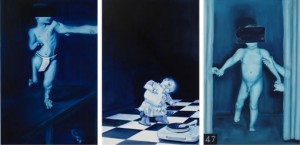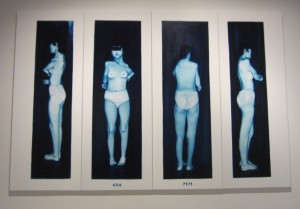damaged – thalidomide victims in medical documents exhibition
Simone Mangos’s DAMAGED – thalidomide victims in medical documents exhibition focuses on the truly horrifying birth defects caused from the pharmaceutical drug thalidomide. Thalidomide was hailed as a super drug in the 1950s and was widely used to treat women’s morning sickness. In the 1960s it was found to be a cause of birth deformities, although it is still in limited use today.
Mangos uses oil paint in the cold and clinical tones of blue to explore the medical photographs and documents associated with those deformed from thalidomide. The photographs that the works are based on come from the 1960s and 1970s from medical books and various other sources including images given to Mangos from the survivors. Mangos attempts to recreate these images accurately and you can’t help but feel outraged at the treatment of these victims, which are all women and children in the exhibition. As said by Mangos “In the history of painting, deformed people are typically represented as monsters, criminals and objects of contempt. Medical photography, at least up until the late 1980s, has mostly not been any different. It is the individual victim who has to strip, have their body prodded, probed, stared at, photographed, discussed and decided upon as if they were not even present.”
Children’s arms are grabbed and in one a baby girl is held upside down. The victim’s eyes are blanked out by rectangular shading, which further dehumanises them. In The Patient visited the clinic only once there are four painted panels showing a female teenager from each angle as if she were an object on display. She wears medical see-through underwear and uncomforatbly stands topless before the scientists. The accompanying text is quite horrifying: “The patient was born on August 30, 1960. She visited the clinic at the age of 17. Examinations in the first visit demonstrated normal secondary sexual characteristics such as breast development and vulvar appearance. The labium minus pudenda and hymen were normal” and continues in this manner and then states that she only visited the clinic once so that they were unable to do further testing on her. It is hardly surprising. Through this view the human becomes a medical curiosity viewed under a clinical gaze.
These works are confronting and forces you to view these individuals in the way that the scientists did. It is held at the Art Gallery of New South Wales until August 5, 2012. Free Admission.



